Preventing Falls Among the Elderly: A Comprehensive Healthcare Report
VerifiedAdded on 2022/10/08
|13
|3724
|42
Report
AI Summary
This report focuses on the critical issue of fall prevention among the elderly, a significant health concern in communities. It begins by highlighting the increasing incidence of falls, particularly in Australia, and the associated rise in healthcare costs and mortality rates. The report delves into the discussion of fall injury cases, reviewing past studies on fall-related injuries and hospitalizations, including the common types of injuries such as hip fractures and head injuries. It also examines the impact of falls on the elderly, including the consequences of 'long lie' and its implications for patient outcomes. The report then proposes a model for improvement using the PDSA cycle, outlining the planning, implementation, study, and action phases of a fall prevention program. The importance of effective nursing leadership and management is emphasized to ensure the success of such programs. The report concludes by emphasizing the need for a multidisciplinary approach to fall prevention, involving nurses, patients, families, physicians, and pharmacists. It stresses the importance of patient-oriented care, the integration of fall prevention with other patient needs, and the necessity of continuous monitoring and evaluation to improve patient safety and quality of life. The study aims to answer fundamental questions related to fall prevention, examining the consequences of fall-prevention involvements and the disturbance caused due to these involvements.

Running head: PREVENTION OF FALL AMONGST THE ELDERLY
Name of the Student:
Name of the University:
Authors Note:
Name of the Student:
Name of the University:
Authors Note:
Paraphrase This Document
Need a fresh take? Get an instant paraphrase of this document with our AI Paraphraser
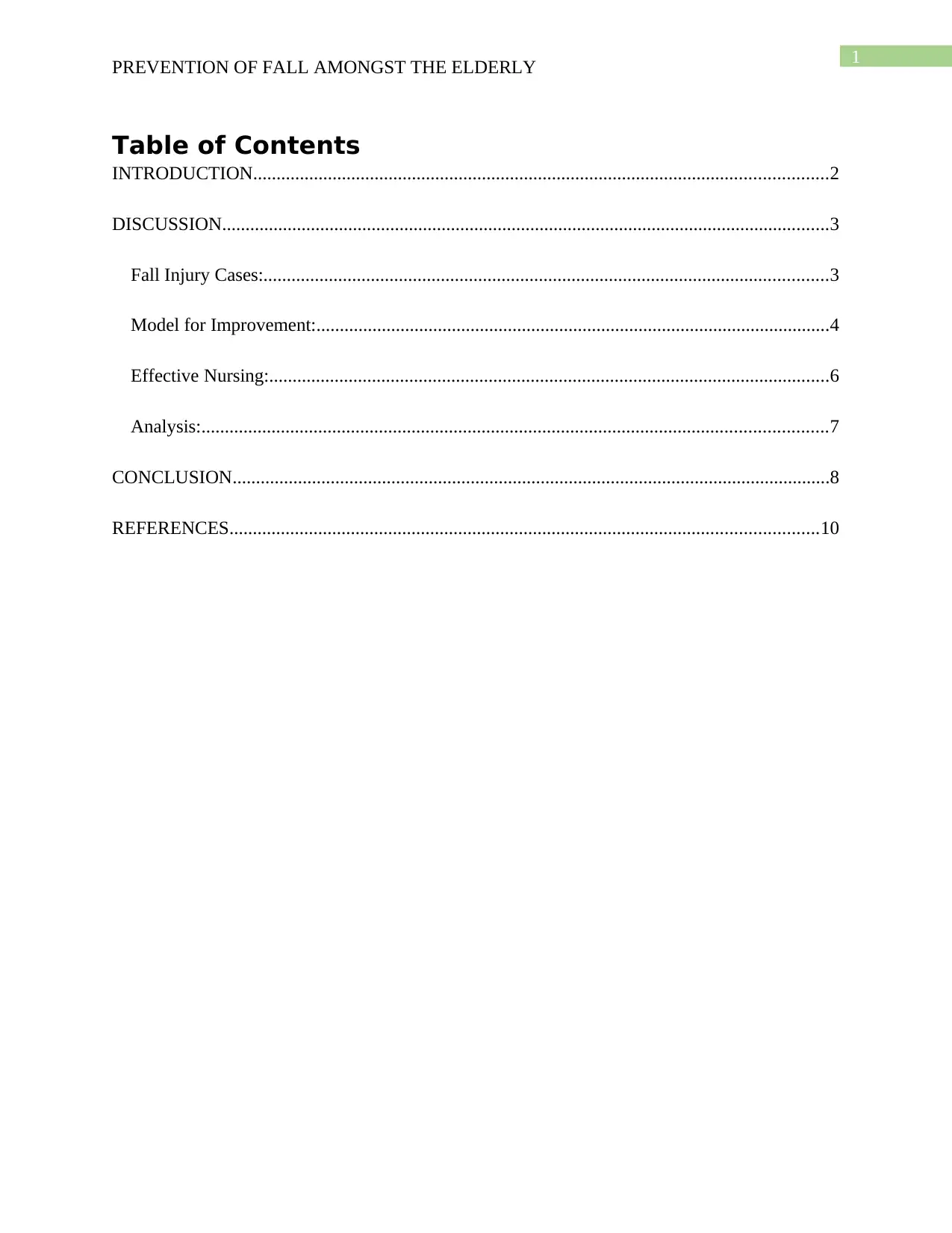
1
PREVENTION OF FALL AMONGST THE ELDERLY
Table of Contents
INTRODUCTION...........................................................................................................................2
DISCUSSION..................................................................................................................................3
Fall Injury Cases:.........................................................................................................................3
Model for Improvement:..............................................................................................................4
Effective Nursing:........................................................................................................................6
Analysis:......................................................................................................................................7
CONCLUSION................................................................................................................................8
REFERENCES..............................................................................................................................10
PREVENTION OF FALL AMONGST THE ELDERLY
Table of Contents
INTRODUCTION...........................................................................................................................2
DISCUSSION..................................................................................................................................3
Fall Injury Cases:.........................................................................................................................3
Model for Improvement:..............................................................................................................4
Effective Nursing:........................................................................................................................6
Analysis:......................................................................................................................................7
CONCLUSION................................................................................................................................8
REFERENCES..............................................................................................................................10
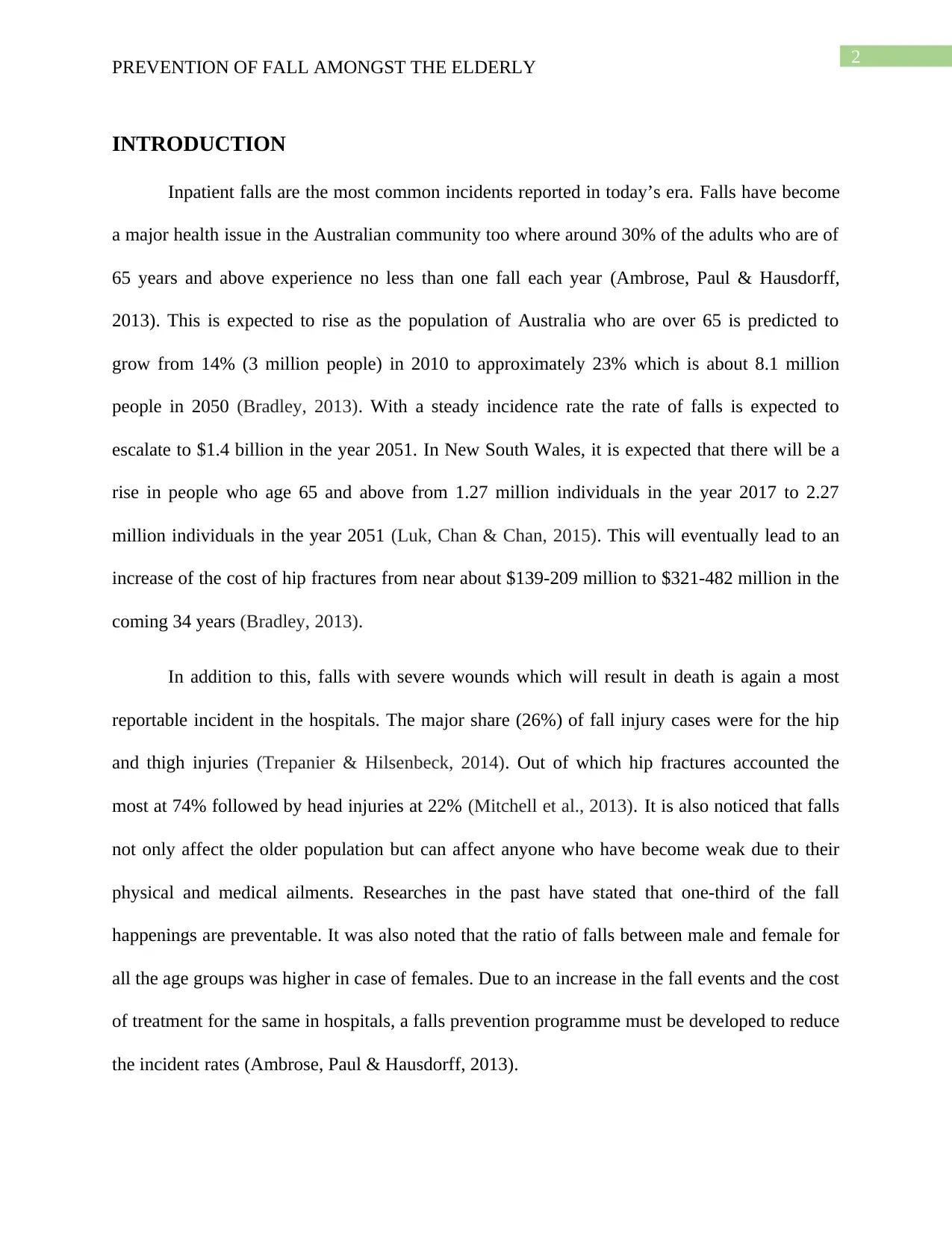
2
PREVENTION OF FALL AMONGST THE ELDERLY
INTRODUCTION
Inpatient falls are the most common incidents reported in today’s era. Falls have become
a major health issue in the Australian community too where around 30% of the adults who are of
65 years and above experience no less than one fall each year (Ambrose, Paul & Hausdorff,
2013). This is expected to rise as the population of Australia who are over 65 is predicted to
grow from 14% (3 million people) in 2010 to approximately 23% which is about 8.1 million
people in 2050 (Bradley, 2013). With a steady incidence rate the rate of falls is expected to
escalate to $1.4 billion in the year 2051. In New South Wales, it is expected that there will be a
rise in people who age 65 and above from 1.27 million individuals in the year 2017 to 2.27
million individuals in the year 2051 (Luk, Chan & Chan, 2015). This will eventually lead to an
increase of the cost of hip fractures from near about $139-209 million to $321-482 million in the
coming 34 years (Bradley, 2013).
In addition to this, falls with severe wounds which will result in death is again a most
reportable incident in the hospitals. The major share (26%) of fall injury cases were for the hip
and thigh injuries (Trepanier & Hilsenbeck, 2014). Out of which hip fractures accounted the
most at 74% followed by head injuries at 22% (Mitchell et al., 2013). It is also noticed that falls
not only affect the older population but can affect anyone who have become weak due to their
physical and medical ailments. Researches in the past have stated that one-third of the fall
happenings are preventable. It was also noted that the ratio of falls between male and female for
all the age groups was higher in case of females. Due to an increase in the fall events and the cost
of treatment for the same in hospitals, a falls prevention programme must be developed to reduce
the incident rates (Ambrose, Paul & Hausdorff, 2013).
PREVENTION OF FALL AMONGST THE ELDERLY
INTRODUCTION
Inpatient falls are the most common incidents reported in today’s era. Falls have become
a major health issue in the Australian community too where around 30% of the adults who are of
65 years and above experience no less than one fall each year (Ambrose, Paul & Hausdorff,
2013). This is expected to rise as the population of Australia who are over 65 is predicted to
grow from 14% (3 million people) in 2010 to approximately 23% which is about 8.1 million
people in 2050 (Bradley, 2013). With a steady incidence rate the rate of falls is expected to
escalate to $1.4 billion in the year 2051. In New South Wales, it is expected that there will be a
rise in people who age 65 and above from 1.27 million individuals in the year 2017 to 2.27
million individuals in the year 2051 (Luk, Chan & Chan, 2015). This will eventually lead to an
increase of the cost of hip fractures from near about $139-209 million to $321-482 million in the
coming 34 years (Bradley, 2013).
In addition to this, falls with severe wounds which will result in death is again a most
reportable incident in the hospitals. The major share (26%) of fall injury cases were for the hip
and thigh injuries (Trepanier & Hilsenbeck, 2014). Out of which hip fractures accounted the
most at 74% followed by head injuries at 22% (Mitchell et al., 2013). It is also noticed that falls
not only affect the older population but can affect anyone who have become weak due to their
physical and medical ailments. Researches in the past have stated that one-third of the fall
happenings are preventable. It was also noted that the ratio of falls between male and female for
all the age groups was higher in case of females. Due to an increase in the fall events and the cost
of treatment for the same in hospitals, a falls prevention programme must be developed to reduce
the incident rates (Ambrose, Paul & Hausdorff, 2013).
⊘ This is a preview!⊘
Do you want full access?
Subscribe today to unlock all pages.

Trusted by 1+ million students worldwide
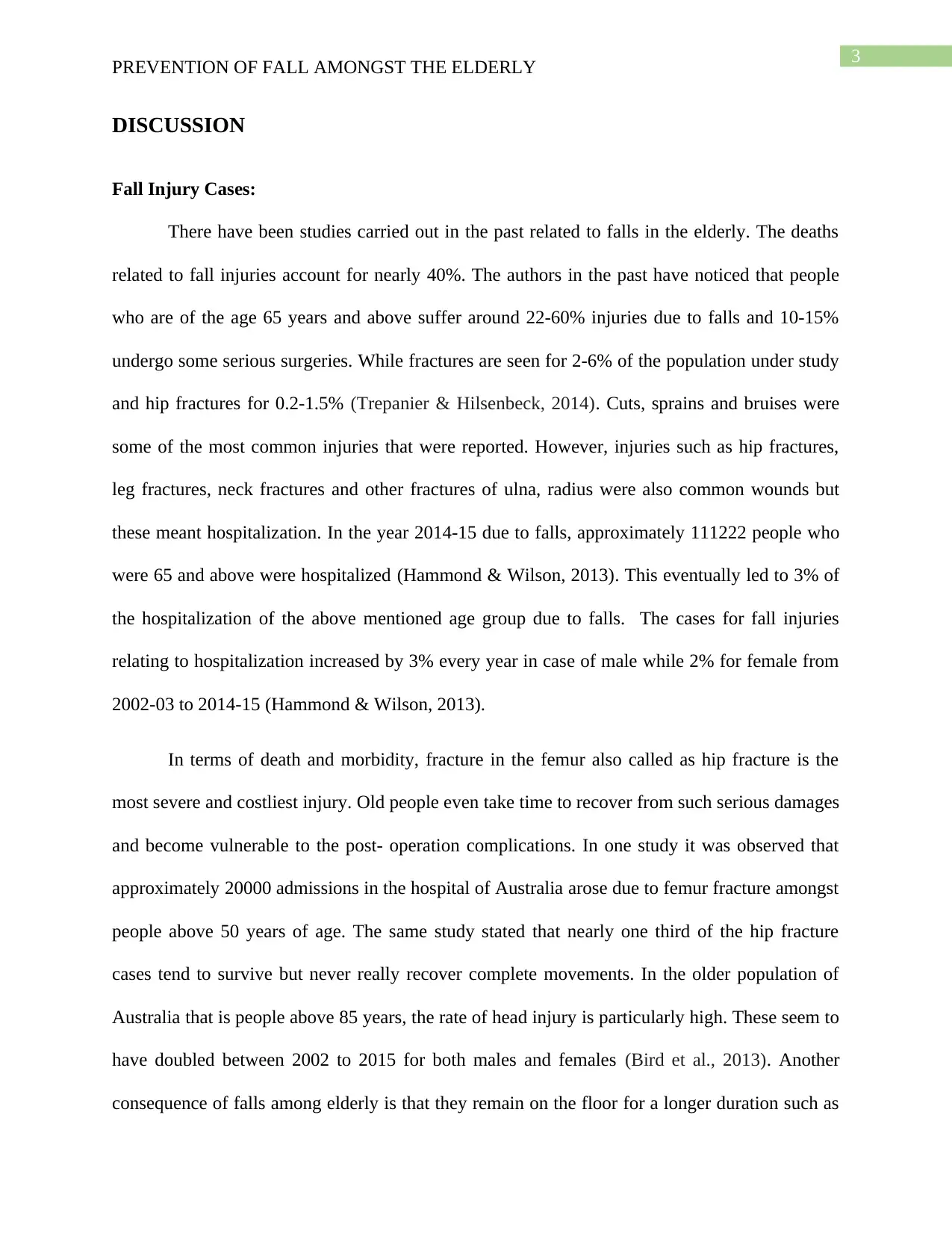
3
PREVENTION OF FALL AMONGST THE ELDERLY
DISCUSSION
Fall Injury Cases:
There have been studies carried out in the past related to falls in the elderly. The deaths
related to fall injuries account for nearly 40%. The authors in the past have noticed that people
who are of the age 65 years and above suffer around 22-60% injuries due to falls and 10-15%
undergo some serious surgeries. While fractures are seen for 2-6% of the population under study
and hip fractures for 0.2-1.5% (Trepanier & Hilsenbeck, 2014). Cuts, sprains and bruises were
some of the most common injuries that were reported. However, injuries such as hip fractures,
leg fractures, neck fractures and other fractures of ulna, radius were also common wounds but
these meant hospitalization. In the year 2014-15 due to falls, approximately 111222 people who
were 65 and above were hospitalized (Hammond & Wilson, 2013). This eventually led to 3% of
the hospitalization of the above mentioned age group due to falls. The cases for fall injuries
relating to hospitalization increased by 3% every year in case of male while 2% for female from
2002-03 to 2014-15 (Hammond & Wilson, 2013).
In terms of death and morbidity, fracture in the femur also called as hip fracture is the
most severe and costliest injury. Old people even take time to recover from such serious damages
and become vulnerable to the post- operation complications. In one study it was observed that
approximately 20000 admissions in the hospital of Australia arose due to femur fracture amongst
people above 50 years of age. The same study stated that nearly one third of the hip fracture
cases tend to survive but never really recover complete movements. In the older population of
Australia that is people above 85 years, the rate of head injury is particularly high. These seem to
have doubled between 2002 to 2015 for both males and females (Bird et al., 2013). Another
consequence of falls among elderly is that they remain on the floor for a longer duration such as
PREVENTION OF FALL AMONGST THE ELDERLY
DISCUSSION
Fall Injury Cases:
There have been studies carried out in the past related to falls in the elderly. The deaths
related to fall injuries account for nearly 40%. The authors in the past have noticed that people
who are of the age 65 years and above suffer around 22-60% injuries due to falls and 10-15%
undergo some serious surgeries. While fractures are seen for 2-6% of the population under study
and hip fractures for 0.2-1.5% (Trepanier & Hilsenbeck, 2014). Cuts, sprains and bruises were
some of the most common injuries that were reported. However, injuries such as hip fractures,
leg fractures, neck fractures and other fractures of ulna, radius were also common wounds but
these meant hospitalization. In the year 2014-15 due to falls, approximately 111222 people who
were 65 and above were hospitalized (Hammond & Wilson, 2013). This eventually led to 3% of
the hospitalization of the above mentioned age group due to falls. The cases for fall injuries
relating to hospitalization increased by 3% every year in case of male while 2% for female from
2002-03 to 2014-15 (Hammond & Wilson, 2013).
In terms of death and morbidity, fracture in the femur also called as hip fracture is the
most severe and costliest injury. Old people even take time to recover from such serious damages
and become vulnerable to the post- operation complications. In one study it was observed that
approximately 20000 admissions in the hospital of Australia arose due to femur fracture amongst
people above 50 years of age. The same study stated that nearly one third of the hip fracture
cases tend to survive but never really recover complete movements. In the older population of
Australia that is people above 85 years, the rate of head injury is particularly high. These seem to
have doubled between 2002 to 2015 for both males and females (Bird et al., 2013). Another
consequence of falls among elderly is that they remain on the floor for a longer duration such as
Paraphrase This Document
Need a fresh take? Get an instant paraphrase of this document with our AI Paraphraser
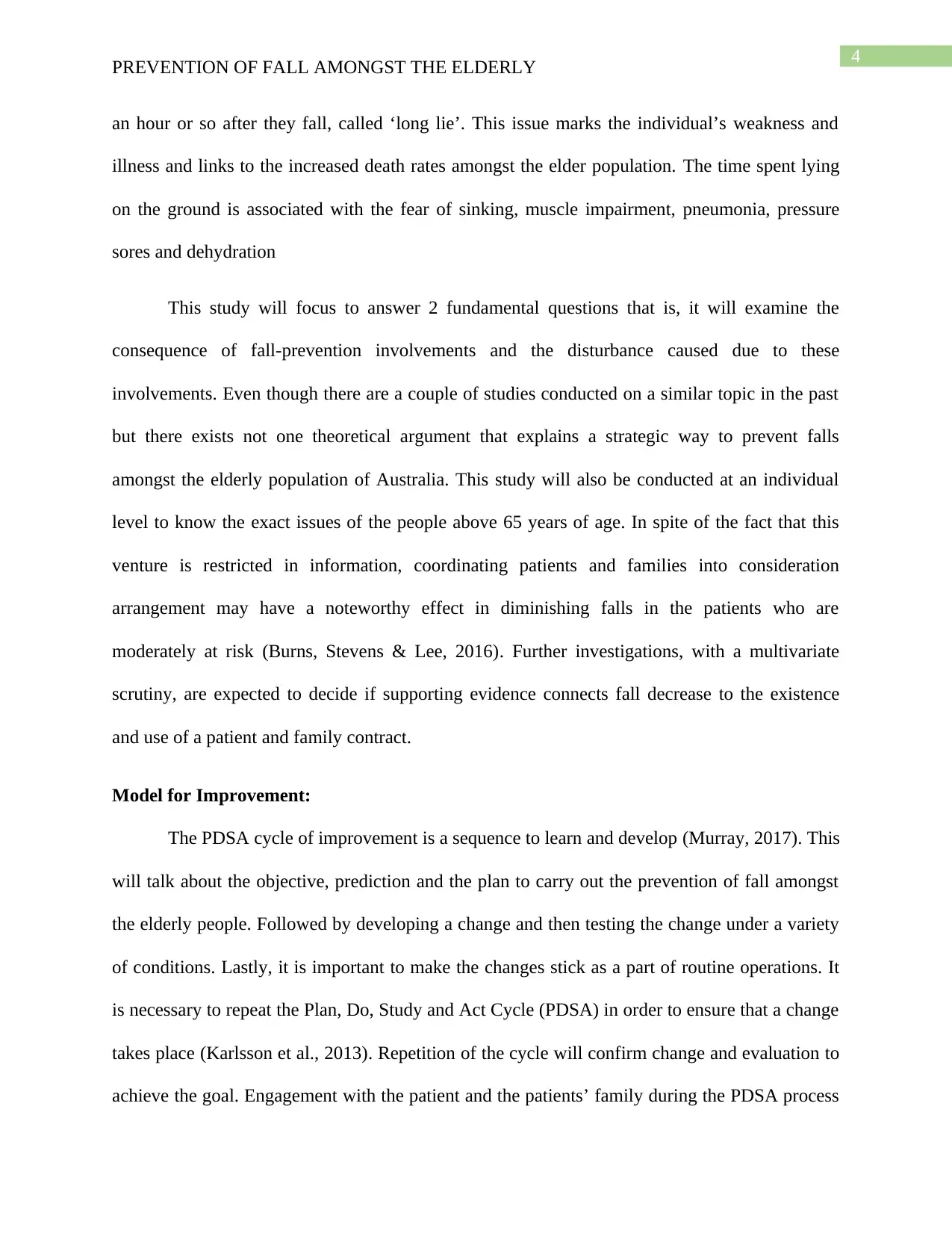
4
PREVENTION OF FALL AMONGST THE ELDERLY
an hour or so after they fall, called ‘long lie’. This issue marks the individual’s weakness and
illness and links to the increased death rates amongst the elder population. The time spent lying
on the ground is associated with the fear of sinking, muscle impairment, pneumonia, pressure
sores and dehydration
This study will focus to answer 2 fundamental questions that is, it will examine the
consequence of fall-prevention involvements and the disturbance caused due to these
involvements. Even though there are a couple of studies conducted on a similar topic in the past
but there exists not one theoretical argument that explains a strategic way to prevent falls
amongst the elderly population of Australia. This study will also be conducted at an individual
level to know the exact issues of the people above 65 years of age. In spite of the fact that this
venture is restricted in information, coordinating patients and families into consideration
arrangement may have a noteworthy effect in diminishing falls in the patients who are
moderately at risk (Burns, Stevens & Lee, 2016). Further investigations, with a multivariate
scrutiny, are expected to decide if supporting evidence connects fall decrease to the existence
and use of a patient and family contract.
Model for Improvement:
The PDSA cycle of improvement is a sequence to learn and develop (Murray, 2017). This
will talk about the objective, prediction and the plan to carry out the prevention of fall amongst
the elderly people. Followed by developing a change and then testing the change under a variety
of conditions. Lastly, it is important to make the changes stick as a part of routine operations. It
is necessary to repeat the Plan, Do, Study and Act Cycle (PDSA) in order to ensure that a change
takes place (Karlsson et al., 2013). Repetition of the cycle will confirm change and evaluation to
achieve the goal. Engagement with the patient and the patients’ family during the PDSA process
PREVENTION OF FALL AMONGST THE ELDERLY
an hour or so after they fall, called ‘long lie’. This issue marks the individual’s weakness and
illness and links to the increased death rates amongst the elder population. The time spent lying
on the ground is associated with the fear of sinking, muscle impairment, pneumonia, pressure
sores and dehydration
This study will focus to answer 2 fundamental questions that is, it will examine the
consequence of fall-prevention involvements and the disturbance caused due to these
involvements. Even though there are a couple of studies conducted on a similar topic in the past
but there exists not one theoretical argument that explains a strategic way to prevent falls
amongst the elderly population of Australia. This study will also be conducted at an individual
level to know the exact issues of the people above 65 years of age. In spite of the fact that this
venture is restricted in information, coordinating patients and families into consideration
arrangement may have a noteworthy effect in diminishing falls in the patients who are
moderately at risk (Burns, Stevens & Lee, 2016). Further investigations, with a multivariate
scrutiny, are expected to decide if supporting evidence connects fall decrease to the existence
and use of a patient and family contract.
Model for Improvement:
The PDSA cycle of improvement is a sequence to learn and develop (Murray, 2017). This
will talk about the objective, prediction and the plan to carry out the prevention of fall amongst
the elderly people. Followed by developing a change and then testing the change under a variety
of conditions. Lastly, it is important to make the changes stick as a part of routine operations. It
is necessary to repeat the Plan, Do, Study and Act Cycle (PDSA) in order to ensure that a change
takes place (Karlsson et al., 2013). Repetition of the cycle will confirm change and evaluation to
achieve the goal. Engagement with the patient and the patients’ family during the PDSA process
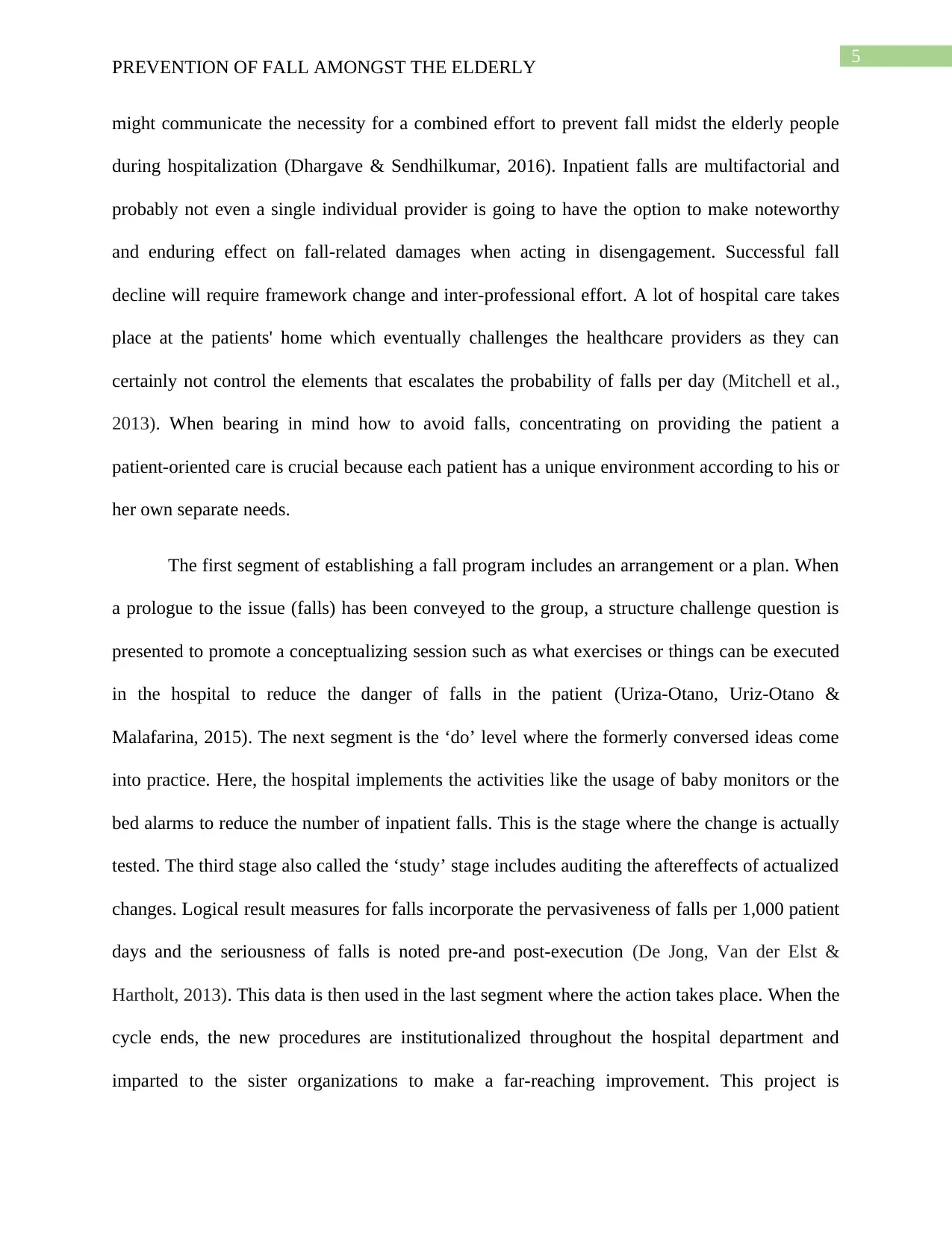
5
PREVENTION OF FALL AMONGST THE ELDERLY
might communicate the necessity for a combined effort to prevent fall midst the elderly people
during hospitalization (Dhargave & Sendhilkumar, 2016). Inpatient falls are multifactorial and
probably not even a single individual provider is going to have the option to make noteworthy
and enduring effect on fall-related damages when acting in disengagement. Successful fall
decline will require framework change and inter-professional effort. A lot of hospital care takes
place at the patients' home which eventually challenges the healthcare providers as they can
certainly not control the elements that escalates the probability of falls per day (Mitchell et al.,
2013). When bearing in mind how to avoid falls, concentrating on providing the patient a
patient-oriented care is crucial because each patient has a unique environment according to his or
her own separate needs.
The first segment of establishing a fall program includes an arrangement or a plan. When
a prologue to the issue (falls) has been conveyed to the group, a structure challenge question is
presented to promote a conceptualizing session such as what exercises or things can be executed
in the hospital to reduce the danger of falls in the patient (Uriza-Otano, Uriz-Otano &
Malafarina, 2015). The next segment is the ‘do’ level where the formerly conversed ideas come
into practice. Here, the hospital implements the activities like the usage of baby monitors or the
bed alarms to reduce the number of inpatient falls. This is the stage where the change is actually
tested. The third stage also called the ‘study’ stage includes auditing the aftereffects of actualized
changes. Logical result measures for falls incorporate the pervasiveness of falls per 1,000 patient
days and the seriousness of falls is noted pre-and post-execution (De Jong, Van der Elst &
Hartholt, 2013). This data is then used in the last segment where the action takes place. When the
cycle ends, the new procedures are institutionalized throughout the hospital department and
imparted to the sister organizations to make a far-reaching improvement. This project is
PREVENTION OF FALL AMONGST THE ELDERLY
might communicate the necessity for a combined effort to prevent fall midst the elderly people
during hospitalization (Dhargave & Sendhilkumar, 2016). Inpatient falls are multifactorial and
probably not even a single individual provider is going to have the option to make noteworthy
and enduring effect on fall-related damages when acting in disengagement. Successful fall
decline will require framework change and inter-professional effort. A lot of hospital care takes
place at the patients' home which eventually challenges the healthcare providers as they can
certainly not control the elements that escalates the probability of falls per day (Mitchell et al.,
2013). When bearing in mind how to avoid falls, concentrating on providing the patient a
patient-oriented care is crucial because each patient has a unique environment according to his or
her own separate needs.
The first segment of establishing a fall program includes an arrangement or a plan. When
a prologue to the issue (falls) has been conveyed to the group, a structure challenge question is
presented to promote a conceptualizing session such as what exercises or things can be executed
in the hospital to reduce the danger of falls in the patient (Uriza-Otano, Uriz-Otano &
Malafarina, 2015). The next segment is the ‘do’ level where the formerly conversed ideas come
into practice. Here, the hospital implements the activities like the usage of baby monitors or the
bed alarms to reduce the number of inpatient falls. This is the stage where the change is actually
tested. The third stage also called the ‘study’ stage includes auditing the aftereffects of actualized
changes. Logical result measures for falls incorporate the pervasiveness of falls per 1,000 patient
days and the seriousness of falls is noted pre-and post-execution (De Jong, Van der Elst &
Hartholt, 2013). This data is then used in the last segment where the action takes place. When the
cycle ends, the new procedures are institutionalized throughout the hospital department and
imparted to the sister organizations to make a far-reaching improvement. This project is
⊘ This is a preview!⊘
Do you want full access?
Subscribe today to unlock all pages.

Trusted by 1+ million students worldwide
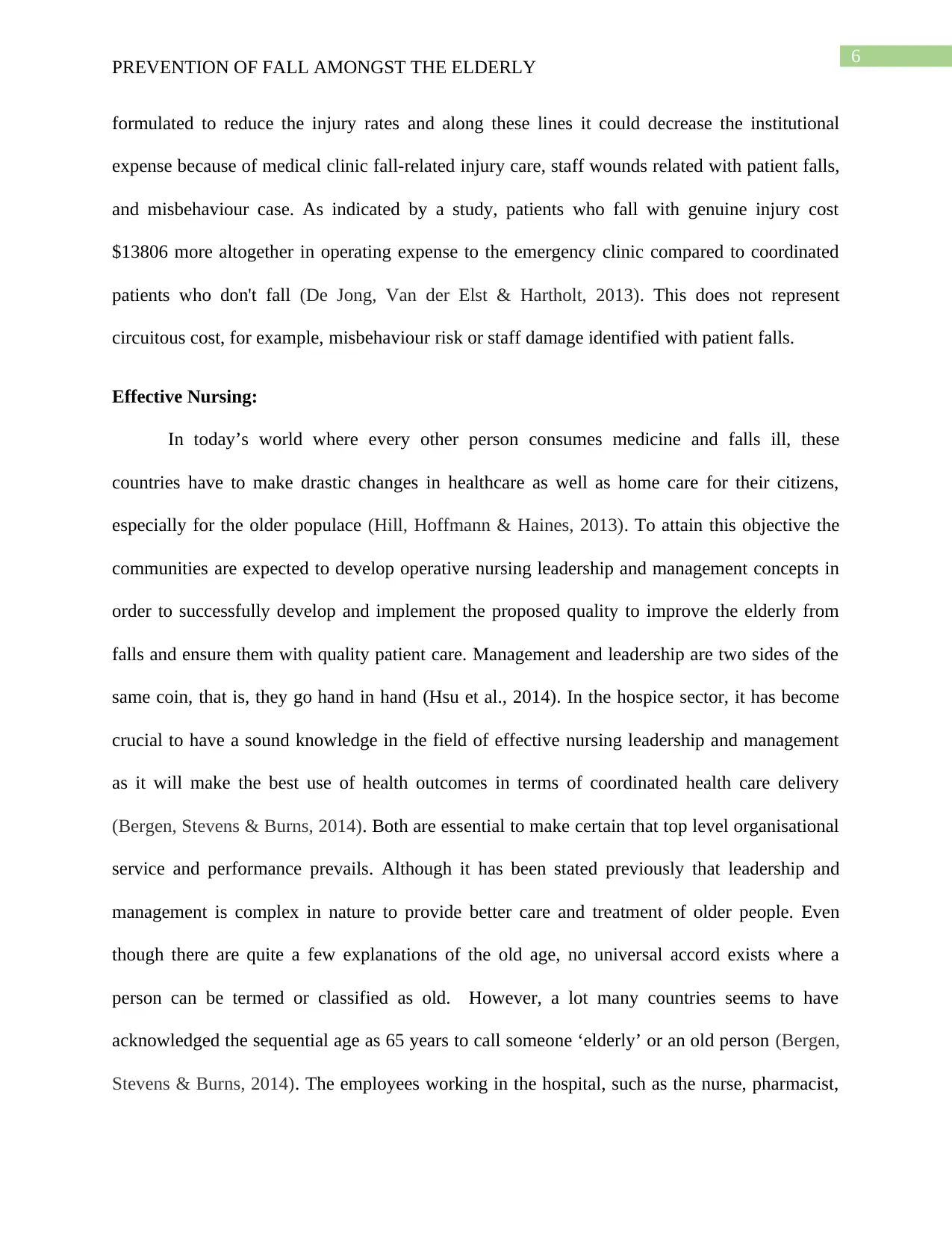
6
PREVENTION OF FALL AMONGST THE ELDERLY
formulated to reduce the injury rates and along these lines it could decrease the institutional
expense because of medical clinic fall-related injury care, staff wounds related with patient falls,
and misbehaviour case. As indicated by a study, patients who fall with genuine injury cost
$13806 more altogether in operating expense to the emergency clinic compared to coordinated
patients who don't fall (De Jong, Van der Elst & Hartholt, 2013). This does not represent
circuitous cost, for example, misbehaviour risk or staff damage identified with patient falls.
Effective Nursing:
In today’s world where every other person consumes medicine and falls ill, these
countries have to make drastic changes in healthcare as well as home care for their citizens,
especially for the older populace (Hill, Hoffmann & Haines, 2013). To attain this objective the
communities are expected to develop operative nursing leadership and management concepts in
order to successfully develop and implement the proposed quality to improve the elderly from
falls and ensure them with quality patient care. Management and leadership are two sides of the
same coin, that is, they go hand in hand (Hsu et al., 2014). In the hospice sector, it has become
crucial to have a sound knowledge in the field of effective nursing leadership and management
as it will make the best use of health outcomes in terms of coordinated health care delivery
(Bergen, Stevens & Burns, 2014). Both are essential to make certain that top level organisational
service and performance prevails. Although it has been stated previously that leadership and
management is complex in nature to provide better care and treatment of older people. Even
though there are quite a few explanations of the old age, no universal accord exists where a
person can be termed or classified as old. However, a lot many countries seems to have
acknowledged the sequential age as 65 years to call someone ‘elderly’ or an old person (Bergen,
Stevens & Burns, 2014). The employees working in the hospital, such as the nurse, pharmacist,
PREVENTION OF FALL AMONGST THE ELDERLY
formulated to reduce the injury rates and along these lines it could decrease the institutional
expense because of medical clinic fall-related injury care, staff wounds related with patient falls,
and misbehaviour case. As indicated by a study, patients who fall with genuine injury cost
$13806 more altogether in operating expense to the emergency clinic compared to coordinated
patients who don't fall (De Jong, Van der Elst & Hartholt, 2013). This does not represent
circuitous cost, for example, misbehaviour risk or staff damage identified with patient falls.
Effective Nursing:
In today’s world where every other person consumes medicine and falls ill, these
countries have to make drastic changes in healthcare as well as home care for their citizens,
especially for the older populace (Hill, Hoffmann & Haines, 2013). To attain this objective the
communities are expected to develop operative nursing leadership and management concepts in
order to successfully develop and implement the proposed quality to improve the elderly from
falls and ensure them with quality patient care. Management and leadership are two sides of the
same coin, that is, they go hand in hand (Hsu et al., 2014). In the hospice sector, it has become
crucial to have a sound knowledge in the field of effective nursing leadership and management
as it will make the best use of health outcomes in terms of coordinated health care delivery
(Bergen, Stevens & Burns, 2014). Both are essential to make certain that top level organisational
service and performance prevails. Although it has been stated previously that leadership and
management is complex in nature to provide better care and treatment of older people. Even
though there are quite a few explanations of the old age, no universal accord exists where a
person can be termed or classified as old. However, a lot many countries seems to have
acknowledged the sequential age as 65 years to call someone ‘elderly’ or an old person (Bergen,
Stevens & Burns, 2014). The employees working in the hospital, such as the nurse, pharmacist,
Paraphrase This Document
Need a fresh take? Get an instant paraphrase of this document with our AI Paraphraser
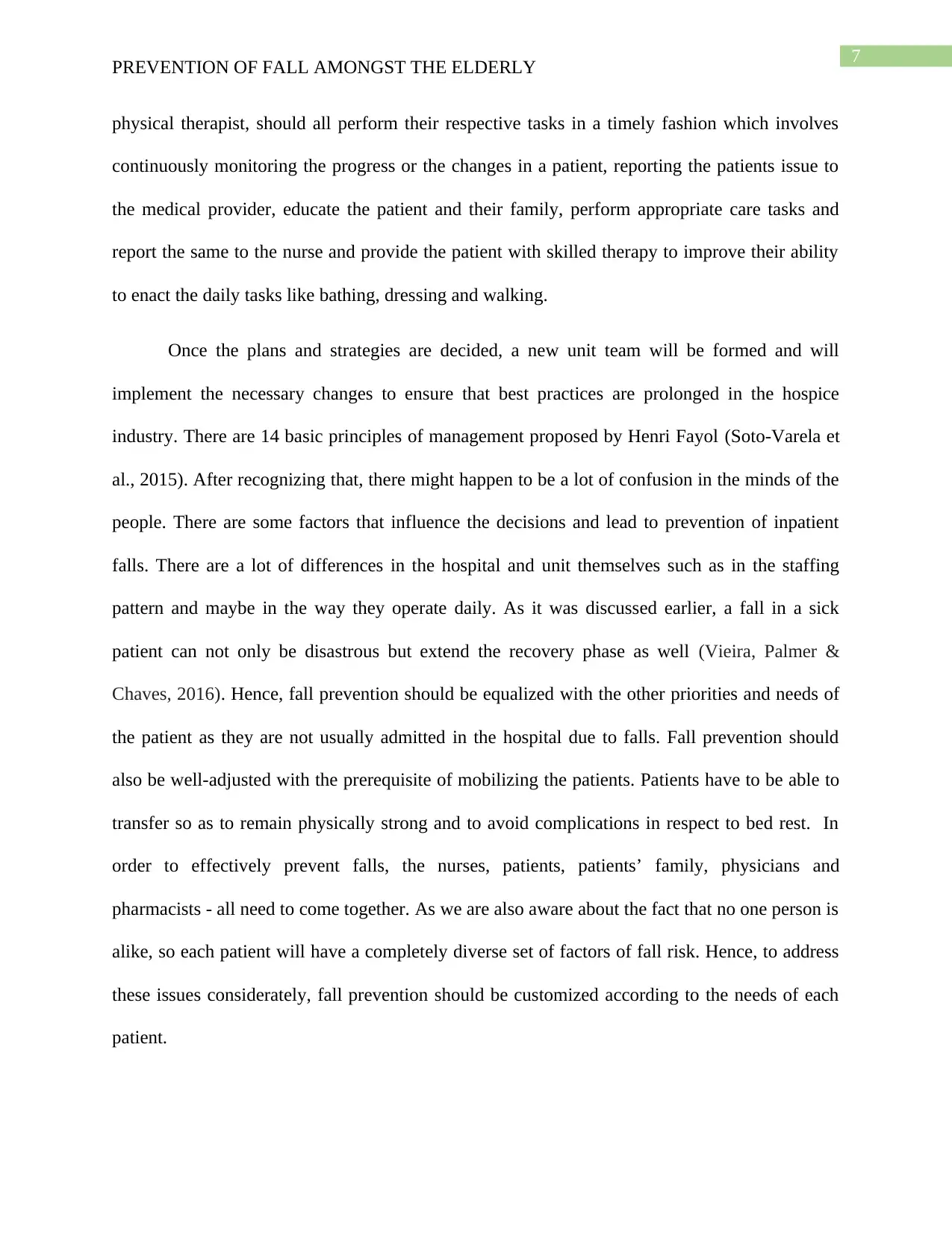
7
PREVENTION OF FALL AMONGST THE ELDERLY
physical therapist, should all perform their respective tasks in a timely fashion which involves
continuously monitoring the progress or the changes in a patient, reporting the patients issue to
the medical provider, educate the patient and their family, perform appropriate care tasks and
report the same to the nurse and provide the patient with skilled therapy to improve their ability
to enact the daily tasks like bathing, dressing and walking.
Once the plans and strategies are decided, a new unit team will be formed and will
implement the necessary changes to ensure that best practices are prolonged in the hospice
industry. There are 14 basic principles of management proposed by Henri Fayol (Soto-Varela et
al., 2015). After recognizing that, there might happen to be a lot of confusion in the minds of the
people. There are some factors that influence the decisions and lead to prevention of inpatient
falls. There are a lot of differences in the hospital and unit themselves such as in the staffing
pattern and maybe in the way they operate daily. As it was discussed earlier, a fall in a sick
patient can not only be disastrous but extend the recovery phase as well (Vieira, Palmer &
Chaves, 2016). Hence, fall prevention should be equalized with the other priorities and needs of
the patient as they are not usually admitted in the hospital due to falls. Fall prevention should
also be well-adjusted with the prerequisite of mobilizing the patients. Patients have to be able to
transfer so as to remain physically strong and to avoid complications in respect to bed rest. In
order to effectively prevent falls, the nurses, patients, patients’ family, physicians and
pharmacists - all need to come together. As we are also aware about the fact that no one person is
alike, so each patient will have a completely diverse set of factors of fall risk. Hence, to address
these issues considerately, fall prevention should be customized according to the needs of each
patient.
PREVENTION OF FALL AMONGST THE ELDERLY
physical therapist, should all perform their respective tasks in a timely fashion which involves
continuously monitoring the progress or the changes in a patient, reporting the patients issue to
the medical provider, educate the patient and their family, perform appropriate care tasks and
report the same to the nurse and provide the patient with skilled therapy to improve their ability
to enact the daily tasks like bathing, dressing and walking.
Once the plans and strategies are decided, a new unit team will be formed and will
implement the necessary changes to ensure that best practices are prolonged in the hospice
industry. There are 14 basic principles of management proposed by Henri Fayol (Soto-Varela et
al., 2015). After recognizing that, there might happen to be a lot of confusion in the minds of the
people. There are some factors that influence the decisions and lead to prevention of inpatient
falls. There are a lot of differences in the hospital and unit themselves such as in the staffing
pattern and maybe in the way they operate daily. As it was discussed earlier, a fall in a sick
patient can not only be disastrous but extend the recovery phase as well (Vieira, Palmer &
Chaves, 2016). Hence, fall prevention should be equalized with the other priorities and needs of
the patient as they are not usually admitted in the hospital due to falls. Fall prevention should
also be well-adjusted with the prerequisite of mobilizing the patients. Patients have to be able to
transfer so as to remain physically strong and to avoid complications in respect to bed rest. In
order to effectively prevent falls, the nurses, patients, patients’ family, physicians and
pharmacists - all need to come together. As we are also aware about the fact that no one person is
alike, so each patient will have a completely diverse set of factors of fall risk. Hence, to address
these issues considerately, fall prevention should be customized according to the needs of each
patient.
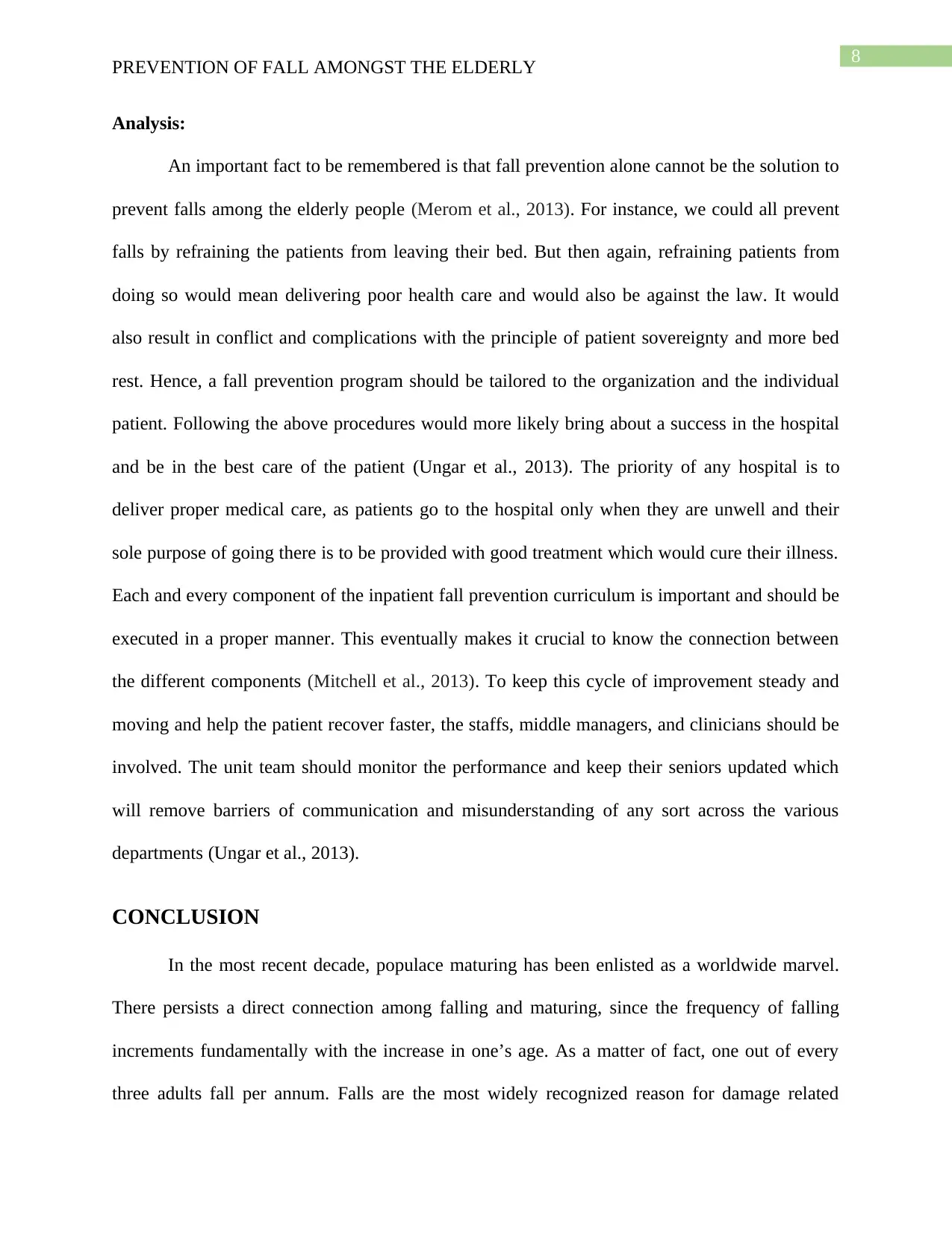
8
PREVENTION OF FALL AMONGST THE ELDERLY
Analysis:
An important fact to be remembered is that fall prevention alone cannot be the solution to
prevent falls among the elderly people (Merom et al., 2013). For instance, we could all prevent
falls by refraining the patients from leaving their bed. But then again, refraining patients from
doing so would mean delivering poor health care and would also be against the law. It would
also result in conflict and complications with the principle of patient sovereignty and more bed
rest. Hence, a fall prevention program should be tailored to the organization and the individual
patient. Following the above procedures would more likely bring about a success in the hospital
and be in the best care of the patient (Ungar et al., 2013). The priority of any hospital is to
deliver proper medical care, as patients go to the hospital only when they are unwell and their
sole purpose of going there is to be provided with good treatment which would cure their illness.
Each and every component of the inpatient fall prevention curriculum is important and should be
executed in a proper manner. This eventually makes it crucial to know the connection between
the different components (Mitchell et al., 2013). To keep this cycle of improvement steady and
moving and help the patient recover faster, the staffs, middle managers, and clinicians should be
involved. The unit team should monitor the performance and keep their seniors updated which
will remove barriers of communication and misunderstanding of any sort across the various
departments (Ungar et al., 2013).
CONCLUSION
In the most recent decade, populace maturing has been enlisted as a worldwide marvel.
There persists a direct connection among falling and maturing, since the frequency of falling
increments fundamentally with the increase in one’s age. As a matter of fact, one out of every
three adults fall per annum. Falls are the most widely recognized reason for damage related
PREVENTION OF FALL AMONGST THE ELDERLY
Analysis:
An important fact to be remembered is that fall prevention alone cannot be the solution to
prevent falls among the elderly people (Merom et al., 2013). For instance, we could all prevent
falls by refraining the patients from leaving their bed. But then again, refraining patients from
doing so would mean delivering poor health care and would also be against the law. It would
also result in conflict and complications with the principle of patient sovereignty and more bed
rest. Hence, a fall prevention program should be tailored to the organization and the individual
patient. Following the above procedures would more likely bring about a success in the hospital
and be in the best care of the patient (Ungar et al., 2013). The priority of any hospital is to
deliver proper medical care, as patients go to the hospital only when they are unwell and their
sole purpose of going there is to be provided with good treatment which would cure their illness.
Each and every component of the inpatient fall prevention curriculum is important and should be
executed in a proper manner. This eventually makes it crucial to know the connection between
the different components (Mitchell et al., 2013). To keep this cycle of improvement steady and
moving and help the patient recover faster, the staffs, middle managers, and clinicians should be
involved. The unit team should monitor the performance and keep their seniors updated which
will remove barriers of communication and misunderstanding of any sort across the various
departments (Ungar et al., 2013).
CONCLUSION
In the most recent decade, populace maturing has been enlisted as a worldwide marvel.
There persists a direct connection among falling and maturing, since the frequency of falling
increments fundamentally with the increase in one’s age. As a matter of fact, one out of every
three adults fall per annum. Falls are the most widely recognized reason for damage related
⊘ This is a preview!⊘
Do you want full access?
Subscribe today to unlock all pages.

Trusted by 1+ million students worldwide
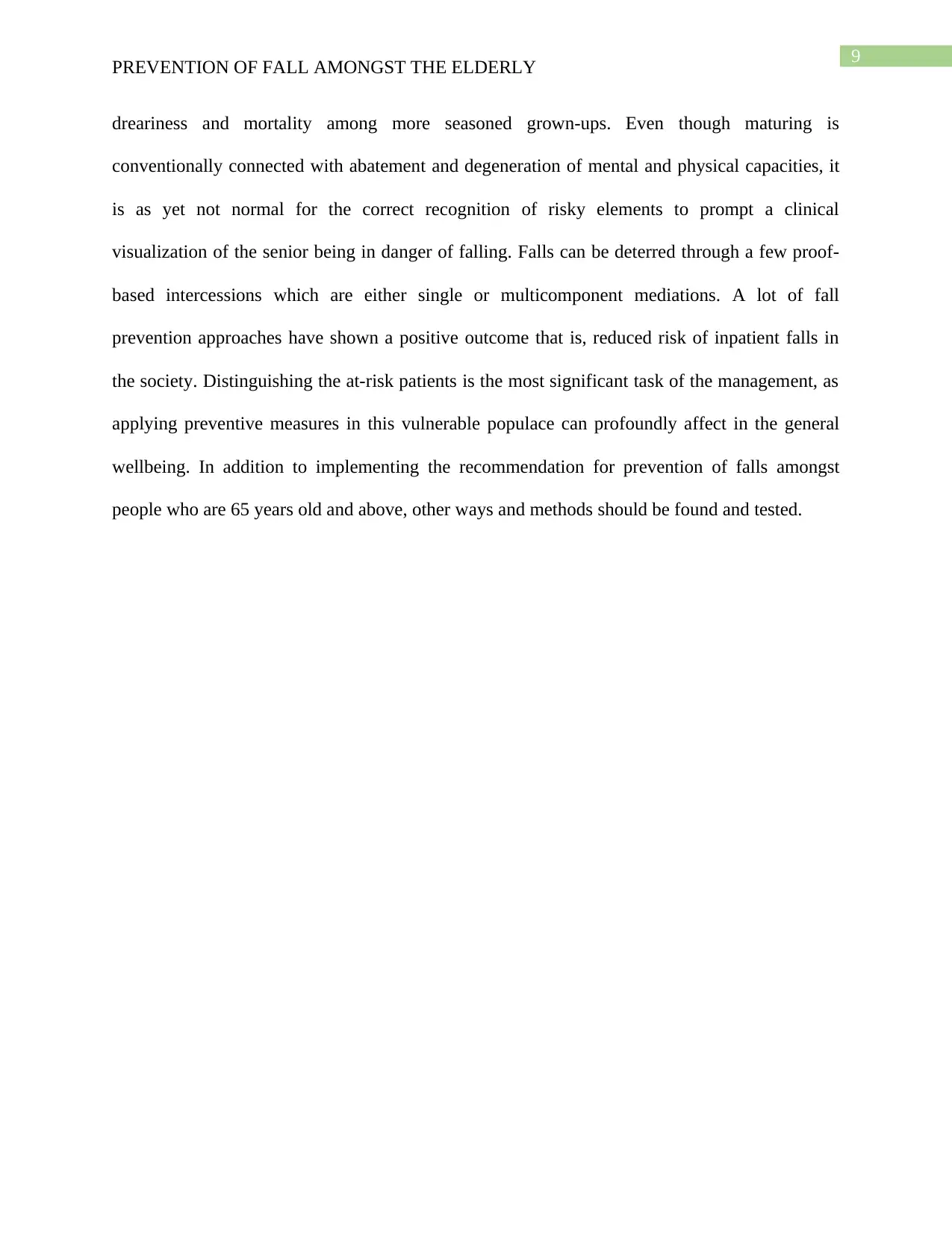
9
PREVENTION OF FALL AMONGST THE ELDERLY
dreariness and mortality among more seasoned grown-ups. Even though maturing is
conventionally connected with abatement and degeneration of mental and physical capacities, it
is as yet not normal for the correct recognition of risky elements to prompt a clinical
visualization of the senior being in danger of falling. Falls can be deterred through a few proof-
based intercessions which are either single or multicomponent mediations. A lot of fall
prevention approaches have shown a positive outcome that is, reduced risk of inpatient falls in
the society. Distinguishing the at-risk patients is the most significant task of the management, as
applying preventive measures in this vulnerable populace can profoundly affect in the general
wellbeing. In addition to implementing the recommendation for prevention of falls amongst
people who are 65 years old and above, other ways and methods should be found and tested.
PREVENTION OF FALL AMONGST THE ELDERLY
dreariness and mortality among more seasoned grown-ups. Even though maturing is
conventionally connected with abatement and degeneration of mental and physical capacities, it
is as yet not normal for the correct recognition of risky elements to prompt a clinical
visualization of the senior being in danger of falling. Falls can be deterred through a few proof-
based intercessions which are either single or multicomponent mediations. A lot of fall
prevention approaches have shown a positive outcome that is, reduced risk of inpatient falls in
the society. Distinguishing the at-risk patients is the most significant task of the management, as
applying preventive measures in this vulnerable populace can profoundly affect in the general
wellbeing. In addition to implementing the recommendation for prevention of falls amongst
people who are 65 years old and above, other ways and methods should be found and tested.
Paraphrase This Document
Need a fresh take? Get an instant paraphrase of this document with our AI Paraphraser
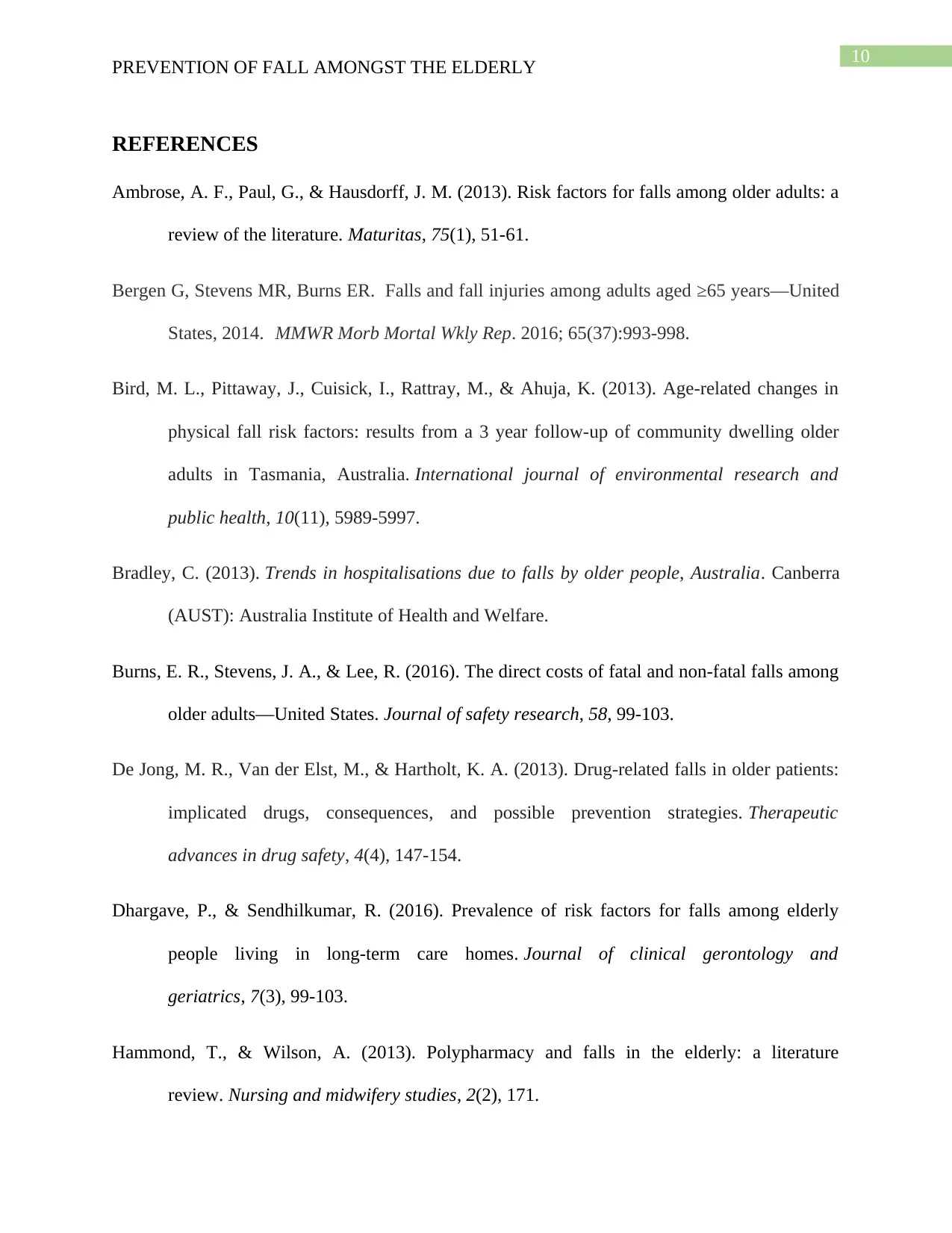
10
PREVENTION OF FALL AMONGST THE ELDERLY
REFERENCES
Ambrose, A. F., Paul, G., & Hausdorff, J. M. (2013). Risk factors for falls among older adults: a
review of the literature. Maturitas, 75(1), 51-61.
Bergen G, Stevens MR, Burns ER. Falls and fall injuries among adults aged ≥65 years—United
States, 2014. MMWR Morb Mortal Wkly Rep. 2016; 65(37):993-998.
Bird, M. L., Pittaway, J., Cuisick, I., Rattray, M., & Ahuja, K. (2013). Age-related changes in
physical fall risk factors: results from a 3 year follow-up of community dwelling older
adults in Tasmania, Australia. International journal of environmental research and
public health, 10(11), 5989-5997.
Bradley, C. (2013). Trends in hospitalisations due to falls by older people, Australia. Canberra
(AUST): Australia Institute of Health and Welfare.
Burns, E. R., Stevens, J. A., & Lee, R. (2016). The direct costs of fatal and non-fatal falls among
older adults—United States. Journal of safety research, 58, 99-103.
De Jong, M. R., Van der Elst, M., & Hartholt, K. A. (2013). Drug-related falls in older patients:
implicated drugs, consequences, and possible prevention strategies. Therapeutic
advances in drug safety, 4(4), 147-154.
Dhargave, P., & Sendhilkumar, R. (2016). Prevalence of risk factors for falls among elderly
people living in long-term care homes. Journal of clinical gerontology and
geriatrics, 7(3), 99-103.
Hammond, T., & Wilson, A. (2013). Polypharmacy and falls in the elderly: a literature
review. Nursing and midwifery studies, 2(2), 171.
PREVENTION OF FALL AMONGST THE ELDERLY
REFERENCES
Ambrose, A. F., Paul, G., & Hausdorff, J. M. (2013). Risk factors for falls among older adults: a
review of the literature. Maturitas, 75(1), 51-61.
Bergen G, Stevens MR, Burns ER. Falls and fall injuries among adults aged ≥65 years—United
States, 2014. MMWR Morb Mortal Wkly Rep. 2016; 65(37):993-998.
Bird, M. L., Pittaway, J., Cuisick, I., Rattray, M., & Ahuja, K. (2013). Age-related changes in
physical fall risk factors: results from a 3 year follow-up of community dwelling older
adults in Tasmania, Australia. International journal of environmental research and
public health, 10(11), 5989-5997.
Bradley, C. (2013). Trends in hospitalisations due to falls by older people, Australia. Canberra
(AUST): Australia Institute of Health and Welfare.
Burns, E. R., Stevens, J. A., & Lee, R. (2016). The direct costs of fatal and non-fatal falls among
older adults—United States. Journal of safety research, 58, 99-103.
De Jong, M. R., Van der Elst, M., & Hartholt, K. A. (2013). Drug-related falls in older patients:
implicated drugs, consequences, and possible prevention strategies. Therapeutic
advances in drug safety, 4(4), 147-154.
Dhargave, P., & Sendhilkumar, R. (2016). Prevalence of risk factors for falls among elderly
people living in long-term care homes. Journal of clinical gerontology and
geriatrics, 7(3), 99-103.
Hammond, T., & Wilson, A. (2013). Polypharmacy and falls in the elderly: a literature
review. Nursing and midwifery studies, 2(2), 171.
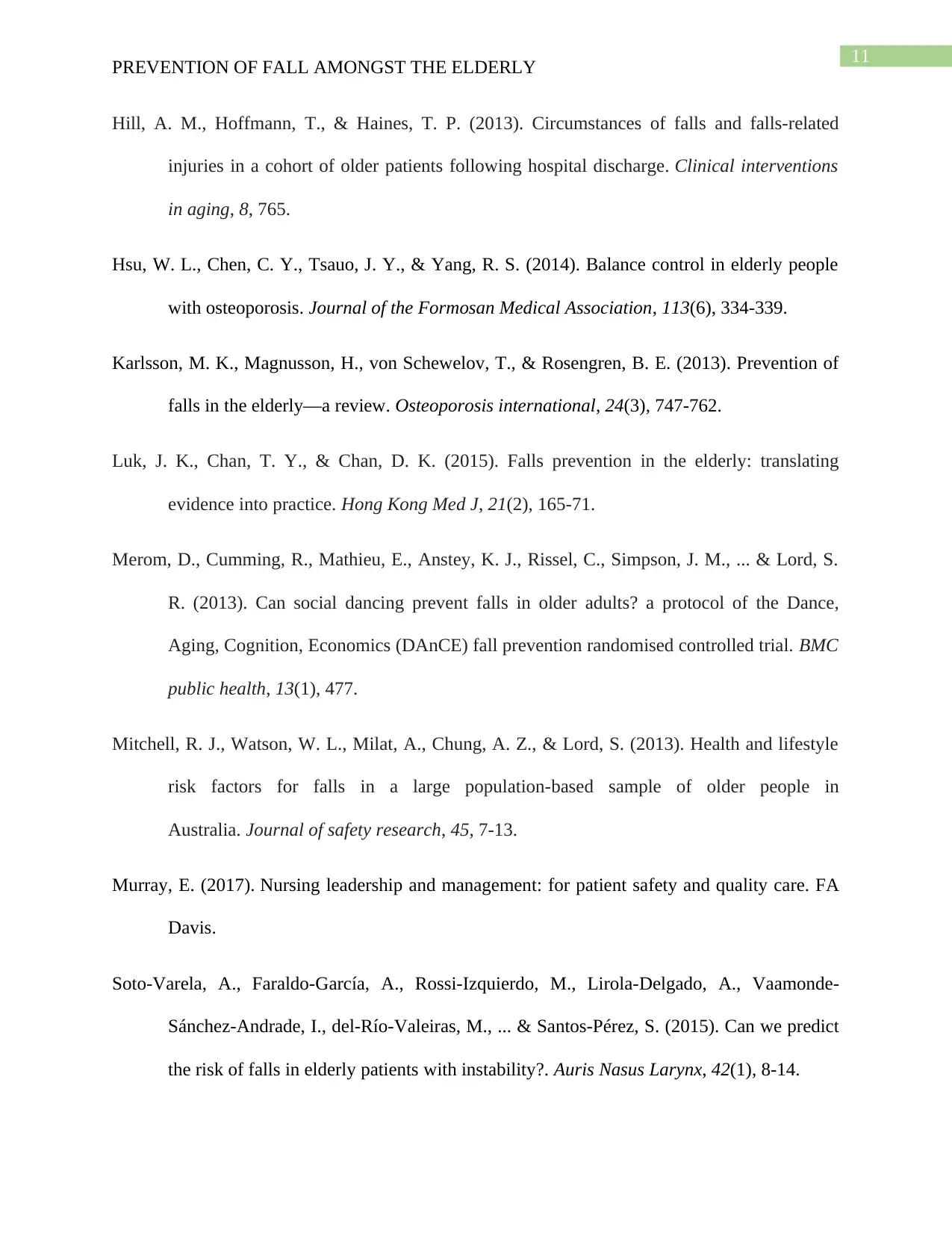
11
PREVENTION OF FALL AMONGST THE ELDERLY
Hill, A. M., Hoffmann, T., & Haines, T. P. (2013). Circumstances of falls and falls-related
injuries in a cohort of older patients following hospital discharge. Clinical interventions
in aging, 8, 765.
Hsu, W. L., Chen, C. Y., Tsauo, J. Y., & Yang, R. S. (2014). Balance control in elderly people
with osteoporosis. Journal of the Formosan Medical Association, 113(6), 334-339.
Karlsson, M. K., Magnusson, H., von Schewelov, T., & Rosengren, B. E. (2013). Prevention of
falls in the elderly—a review. Osteoporosis international, 24(3), 747-762.
Luk, J. K., Chan, T. Y., & Chan, D. K. (2015). Falls prevention in the elderly: translating
evidence into practice. Hong Kong Med J, 21(2), 165-71.
Merom, D., Cumming, R., Mathieu, E., Anstey, K. J., Rissel, C., Simpson, J. M., ... & Lord, S.
R. (2013). Can social dancing prevent falls in older adults? a protocol of the Dance,
Aging, Cognition, Economics (DAnCE) fall prevention randomised controlled trial. BMC
public health, 13(1), 477.
Mitchell, R. J., Watson, W. L., Milat, A., Chung, A. Z., & Lord, S. (2013). Health and lifestyle
risk factors for falls in a large population-based sample of older people in
Australia. Journal of safety research, 45, 7-13.
Murray, E. (2017). Nursing leadership and management: for patient safety and quality care. FA
Davis.
Soto-Varela, A., Faraldo-García, A., Rossi-Izquierdo, M., Lirola-Delgado, A., Vaamonde-
Sánchez-Andrade, I., del-Río-Valeiras, M., ... & Santos-Pérez, S. (2015). Can we predict
the risk of falls in elderly patients with instability?. Auris Nasus Larynx, 42(1), 8-14.
PREVENTION OF FALL AMONGST THE ELDERLY
Hill, A. M., Hoffmann, T., & Haines, T. P. (2013). Circumstances of falls and falls-related
injuries in a cohort of older patients following hospital discharge. Clinical interventions
in aging, 8, 765.
Hsu, W. L., Chen, C. Y., Tsauo, J. Y., & Yang, R. S. (2014). Balance control in elderly people
with osteoporosis. Journal of the Formosan Medical Association, 113(6), 334-339.
Karlsson, M. K., Magnusson, H., von Schewelov, T., & Rosengren, B. E. (2013). Prevention of
falls in the elderly—a review. Osteoporosis international, 24(3), 747-762.
Luk, J. K., Chan, T. Y., & Chan, D. K. (2015). Falls prevention in the elderly: translating
evidence into practice. Hong Kong Med J, 21(2), 165-71.
Merom, D., Cumming, R., Mathieu, E., Anstey, K. J., Rissel, C., Simpson, J. M., ... & Lord, S.
R. (2013). Can social dancing prevent falls in older adults? a protocol of the Dance,
Aging, Cognition, Economics (DAnCE) fall prevention randomised controlled trial. BMC
public health, 13(1), 477.
Mitchell, R. J., Watson, W. L., Milat, A., Chung, A. Z., & Lord, S. (2013). Health and lifestyle
risk factors for falls in a large population-based sample of older people in
Australia. Journal of safety research, 45, 7-13.
Murray, E. (2017). Nursing leadership and management: for patient safety and quality care. FA
Davis.
Soto-Varela, A., Faraldo-García, A., Rossi-Izquierdo, M., Lirola-Delgado, A., Vaamonde-
Sánchez-Andrade, I., del-Río-Valeiras, M., ... & Santos-Pérez, S. (2015). Can we predict
the risk of falls in elderly patients with instability?. Auris Nasus Larynx, 42(1), 8-14.
⊘ This is a preview!⊘
Do you want full access?
Subscribe today to unlock all pages.

Trusted by 1+ million students worldwide
1 out of 13
Related Documents
Your All-in-One AI-Powered Toolkit for Academic Success.
+13062052269
info@desklib.com
Available 24*7 on WhatsApp / Email
![[object Object]](/_next/static/media/star-bottom.7253800d.svg)
Unlock your academic potential
Copyright © 2020–2025 A2Z Services. All Rights Reserved. Developed and managed by ZUCOL.




